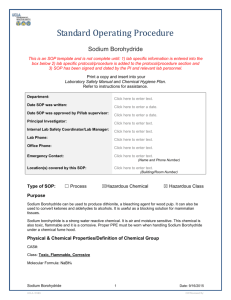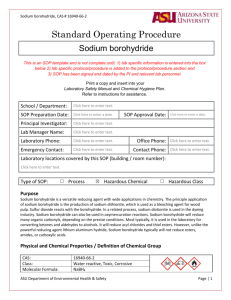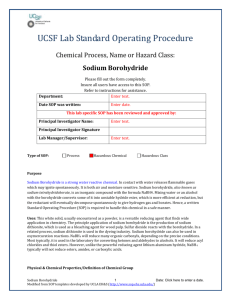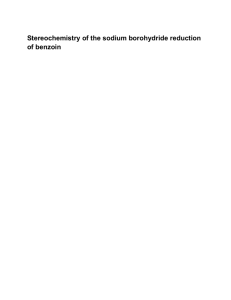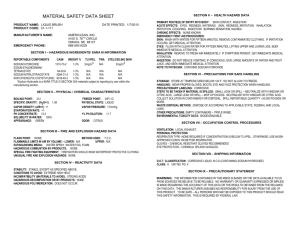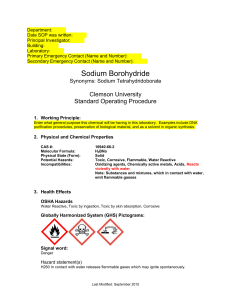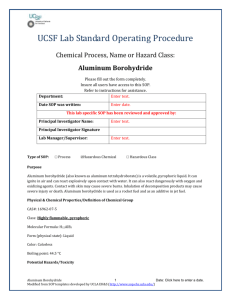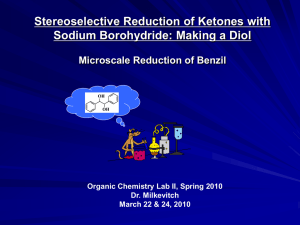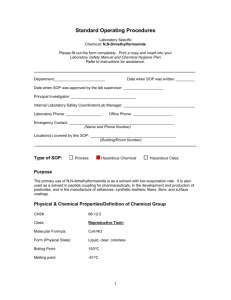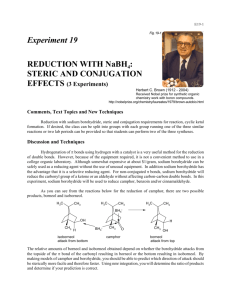UCLA - Environmental Health & Safety
advertisement
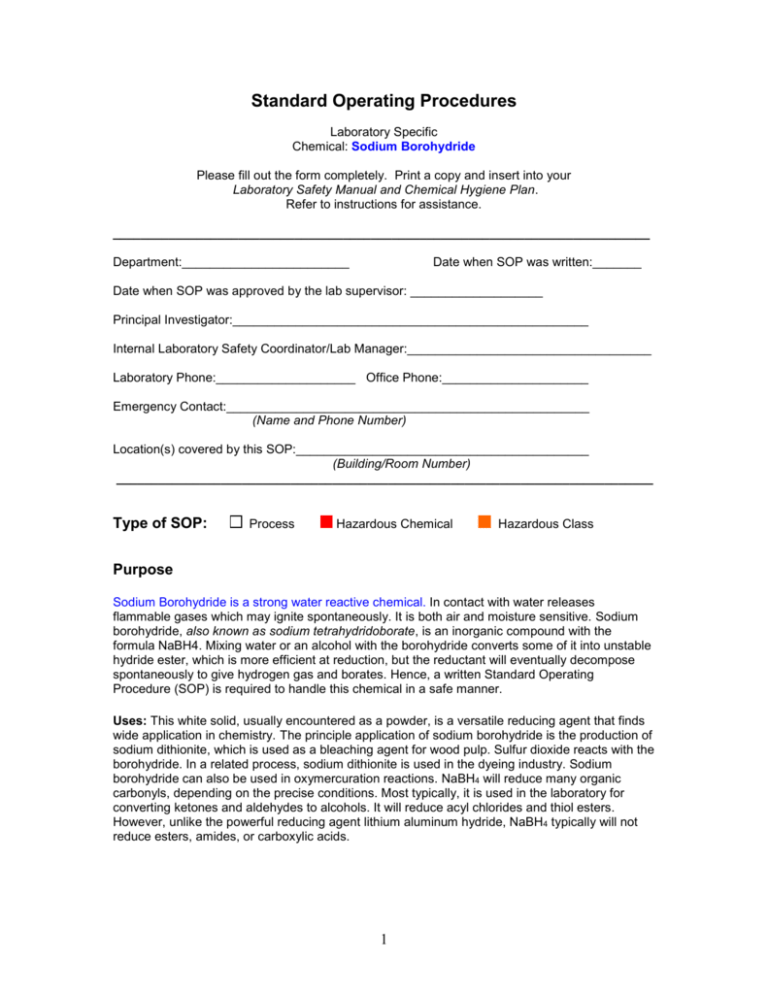
Standard Operating Procedures Laboratory Specific Chemical: Sodium Borohydride Please fill out the form completely. Print a copy and insert into your Laboratory Safety Manual and Chemical Hygiene Plan. Refer to instructions for assistance. _____________________________________________________________________________ Department:________________________ Date when SOP was written:_______ Date when SOP was approved by the lab supervisor: ___________________ Principal Investigator:___________________________________________________ Internal Laboratory Safety Coordinator/Lab Manager:___________________________________ Laboratory Phone:____________________ Office Phone:_____________________ Emergency Contact:____________________________________________________ (Name and Phone Number) Location(s) covered by this SOP:__________________________________________ (Building/Room Number) _____________________________________________________________________________ Type of SOP: Process Hazardous Chemical Hazardous Class Purpose Sodium Borohydride is a strong water reactive chemical. In contact with water releases flammable gases which may ignite spontaneously. It is both air and moisture sensitive. Sodium borohydride, also known as sodium tetrahydridoborate, is an inorganic compound with the formula NaBH4. Mixing water or an alcohol with the borohydride converts some of it into unstable hydride ester, which is more efficient at reduction, but the reductant will eventually decompose spontaneously to give hydrogen gas and borates. Hence, a written Standard Operating Procedure (SOP) is required to handle this chemical in a safe manner. Uses: This white solid, usually encountered as a powder, is a versatile reducing agent that finds wide application in chemistry. The principle application of sodium borohydride is the production of sodium dithionite, which is used as a bleaching agent for wood pulp. Sulfur dioxide reacts with the borohydride. In a related process, sodium dithionite is used in the dyeing industry. Sodium borohydride can also be used in oxymercuration reactions. NaBH4 will reduce many organic carbonyls, depending on the precise conditions. Most typically, it is used in the laboratory for converting ketones and aldehydes to alcohols. It will reduce acyl chlorides and thiol esters. However, unlike the powerful reducing agent lithium aluminum hydride, NaBH4 typically will not reduce esters, amides, or carboxylic acids. 1 Physical & Chemical Properties/Definition of Chemical Group Sodium borohydride is an odorless white to gray-white microcrystalline powder which often forms lumps. It is soluble in water, with which it reacts vigorously. Molecular Formula Molar Mass NaBH4 37.83 g/mol white crystals Appearance hygroscopic Density 1.0740 g/cm3 Melting Point 400 °C Bioling Point 500 °C Solubility in Water soluble, reacts with water soluble in liquid ammonia, amines, Solubility pyridine Potential Hazards/Toxicity Emergency Overview OSHA Hazards Water Reactive, Toxic by ingestion, Toxic by skin absorption, Corrosive GHS Label elements, including precautionary statements Pictogram Signal word Danger Hazard statement(s) H260 In contact with water releases flammable gases which may ignite spontaneously. H301 + H311 Toxic if swallowed or in contact with skin. H314 Causes severe skin burns and eye damage. Precautionary statement(s) P223 Keep away from any possible contact with water, because of violent reaction and possible flash fire. P231 + P232 Handle under inert gas. Protect from moisture. P280 Wear protective gloves/protective clothing/eye protection/face protection. P305 + P351 + P338 IF IN EYES: Rinse cautiously with water for several minutes. Remove contact lenses, if present and easy to do. Continue rinsing. P310 Immediately call a POISON CENTER or doctor/physician. Potential Health Effects Inhalation May be harmful if inhaled. Material is extremely destructive to the tissue of the mucous membranes and upper respiratory tract. Skin Toxic if absorbed through skin. Causes skin burns. Eyes Causes eye burns. Ingestion Toxic if swallowed. Causes burns. 2 Personal Protective Equipment (PPE) Respiratory protection NOTE: Since it is handled/used inside a glove box (under inert atmosphere), respirator is not required. Note: During emergency response, wear Self Contained Breathing Apparatus (SCBA) for fire fighting. Personnel intending to use/wear SCBA respirator must be training and fit-tested by EH&S. This is a regulatory requirement. (http://map.ais.ucla.edu/go/1003938#Respirator_Training_and_Fit_Testing_) Hand protection Handle with nitrile or neoprene gloves. Gloves must be inspected prior to use. Use proper glove removal technique (without touching glove's outer surface) to avoid skin contact with Sodium Borohydride. Wash and dry hands. Eye protection Safety goggles. Use equipment for eye protection tested and approved under appropriate government standards such as NIOSH (US). Skin and body protection Fire/flame resistant lab coat (100% cotton based) Cotton based clothing/attire. Full length pants or equivalent Close toed shoes Hygiene measures Avoid contact with skin, eyes and clothing. Wash hands before breaks and immediately after handling Sodium borohydride. Engineering Controls Glove Box must be used to handle Sodium Borohydride. Must be stored and used under inert atmosphere/conditions. First Aid Procedures General advice Consult a physician. Show this safety data sheet to the doctor in attendance. Move out of dangerous area. If inhaled If breathed in, move person into fresh air. If not breathing give artificial respiration Consult a physician. In case of skin contact Take off contaminated clothing and shoes immediately. Wash off with soap and plenty of water. Take victim immediately to hospital. Consult a physician. In case of eye contact Continue rinsing eyes during transport to hospital. Rinse thoroughly with plenty of water for at least 15 minutes and consult a physician. If swallowed 3 Do NOT induce vomiting. Never give anything by mouth to an unconscious person. Rinse mouth with water. Consult a physician. Special Handling and Storage Requirements Precautions for safe handling Avoid contact with skin and eyes. Avoid formation of Sodium Borohydride dust and aerosols. Provide appropriate exhaust ventilation at places where dust is formed. Keep away from sources of ignition – No open flames (Bunsen burner) Conditions for safe storage Keep container tightly closed in a dry and well-ventilated place. Hazard communication label on the container must read ‘Water Reactive’. Never allow product to get in contact with water/water compounds during storage. Air and moisture sensitive. Store under inert gas (under Noble gases such as Nitrogen or Argon). Keep in a dry place (such as a desiccator or a dry box or glove box). Materials to avoid Oxidizing agents, chemically active metals, acids, water & water based compounds. Spill and Accident Procedure Suitable extinguishing media NOTE: Carbon dioxide (CO2) Dry powder and/or Class-D fire extinguisher Extinguishing media which shall not be used for safety reasons Water Special protective equipment for fire-fighters Wear self contained breathing apparatus for fire fighting if necessary. ACCIDENTAL RELEASE MEASURES Personal precautions Use personal protective equipment. Avoid dust formation. Avoid breathing dust. Ensure adequate ventilation. Remove all sources of ignition. Evacuate personnel to safe areas. Environmental precautions Prevent further leakage or spillage if safe to do so. Do not let product enter drains. Methods and materials for containment and cleaning up Pick up and arrange disposal without creating dust. Do not flush with water. Keep in suitable, closed containers for disposal Chemical Spill Dial 911 and x59797 Spill – Help contaminated or injured persons. Evacuate the spill area. Avoid breathing vapors. Eliminate sources of ignition if the chemical is flammable. If possible, confine the spill to a small area using a spill kit or absorbent material. Keep others from entering contaminated area (e.g., use caution tape, barriers, etc.). Small (<1 L) – If you have training, you may assist in the clean-up effort. Use appropriate personal protective equipment and clean-up material for chemical spilled. Double bag spill waste in clear plastic bags, label and take to the next chemical waste pick-up. 4 Large (>1 L) – Dial 911 (or 310-825-1491 from cell phone) and EH&S at x59797 for assistance. Chemical Spill on Body or Clothes – Remove clothing and rinse body thoroughly in emergency shower for at least 15 minutes. Seek medical attention. Notify supervisor and EH&S at x59797 immediately. Chemical Splash Into Eyes – Immediately rinse eyeball and inner surface of eyelid with water for 15 minutes by forcibly holding the eye open. Seek medical attention. Notify supervisor and EH&S at x59797 immediately. Medical Emergency Dial 911 or x52111 Life Threatening Emergency, After Hours, Weekends And Holidays – Dial 911 (or 310-825-1491 from cell phone) or contact the Ronald Reagan UCLA Medical Center (emergency room) directly at x52111 (located at 757 Westwood Plaza, enter from Gayley Avenue). Note: All serious injuries must be reported to EH&S at x59797 within 8 hours. Non-Life Threatening Emergency– Go to the Occupational Health Facility (OHF), x56771, CHS room 67-120 (This is on the 6th floor, 7th corridor, room 120. Enter through the School of Dentistry on Tiverton Drive and proceed to the “O” elevator to the 6th floor.)Hours: M F, 7:30 a.m. to 4:30 p.m. At all other times report to Ronald Regan UCLA Medical Center (emergency room) at x52111. Note: All serious injuries must be reported to EH&S at x59797 within 8 hours. Needle stick/puncture exposure (as applicable to chemical handling procedure)– Wash the affected area with antiseptic soap and warm water for 15 minutes. For mucous membrane exposure, flush the affected area for 15 minutes using an eyewash station. Page the needle stick nurse by dialing 231 from a campus phone, enter 93333 when prompted and then enter your extension. Hours: M – F, 8:00 a.m. to 4:00 p.m. At all other times report to Ronald Regan UCLA Medical Center (emergency room) at x52111. Note: All needle stick/puncture exposures must be reported to EH&S at x59797 within 8 hours. Decontamination/Waste Disposal Procedure General hazardous waste disposal guidelines: Label Waste o Affix an on-line hazardous waste tag on all waste containers using the Online Tag Program http://otp.ucop.edu/ as soon as the first drop of waste is added to the container Store Waste o Store hazardous waste in closed containers, in secondary containment and in a designated location o Double-bag dry waste using transparent bags http://map.ais.ucla.edu/go/1002774 o Waste must be under the control of the person generating & disposing of it Dispose of Waste o Dispose of regularly generated chemical waste within 90 days o Call EH&S at x61887 for questions o Empty Containers 5 o o Dispose as hazardous waste if it once held extremely hazardous waste (irrespective of the container size) http://ehs.ucla.edu/Pub/ExtremelyHazardousWaste.pdf Consult waste pick-up schedule http://ehs.ucla.edu/pub/HazWaste%20Pickup%20Schedule.pdf Prepare for transport to pick-up location Check on-line waste tag Write date of pick-up on the waste tag Use secondary containment Wear eye protection & closed toe shoes; bring gloves Material Safety Data Sheet (MSDS) Location (State the location of MSDS) Hardcopy or electronic copy must be available for Sodium Borohydride. Online MSDS can be accessed at http://msds.ehs.ucla.edu. Protocol/Procedure (Add specific description of procedure) Any deviation from this SOP requires approval from PI. Documentation of Training (signature of all users is required) Prior to conducting any work with Sodium Borohydride, designated personnel must provide training to his/her laboratory personnel specific to the hazards involved in working with this substance, work area decontamination, and emergency procedures. The Principal Investigator must provide his/her laboratory personnel with a copy of this SOP and a copy of Sodium Borohydride MSDS provided by the manufacturer. The Principal Investigator must ensure that his/her laboratory personnel have attended appropriate laboratory safety training or refresher training within the last two years. I have read and understand the content of this SOP: Name Signature 6 Date
